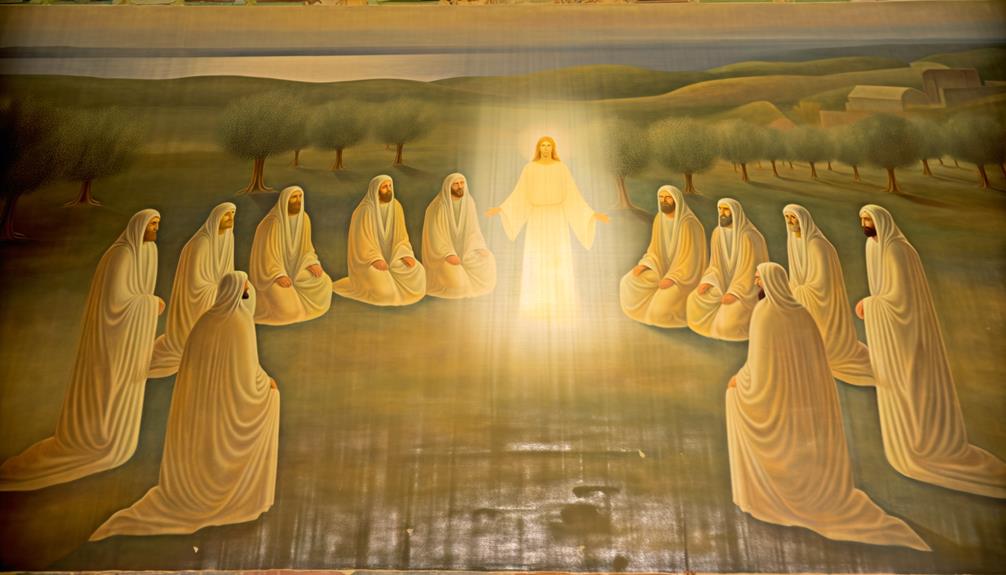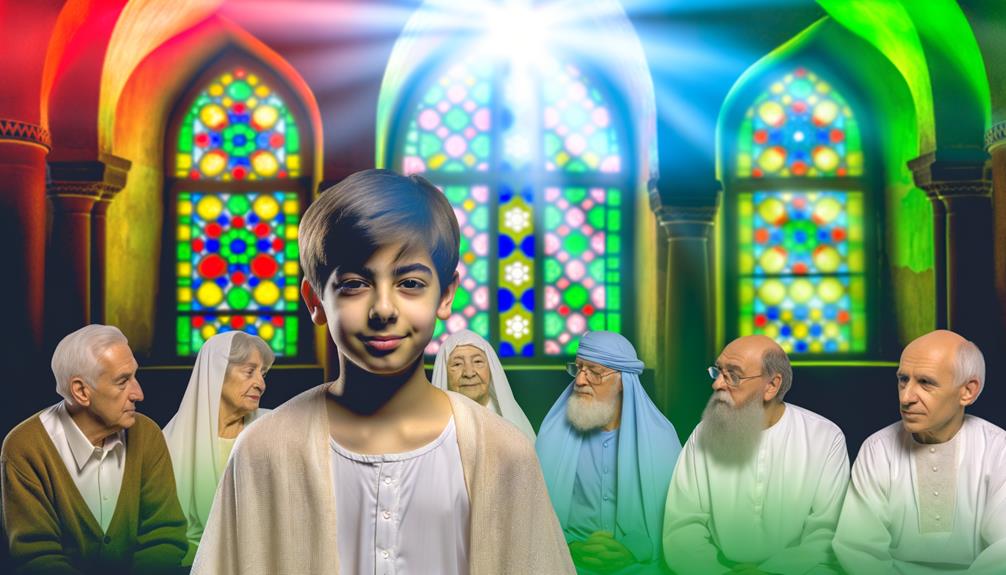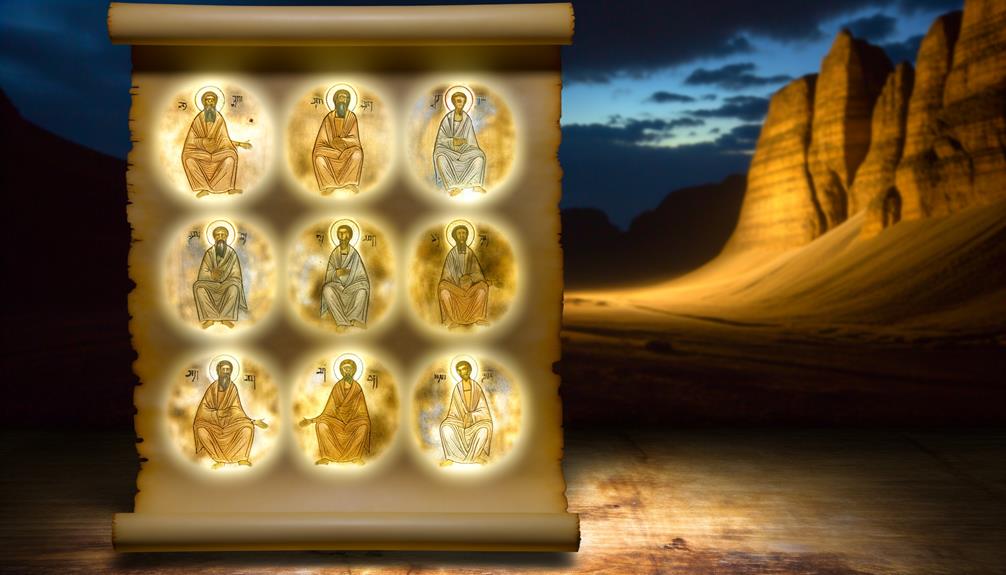Symbolic Meaning of 12 in the Bible: Completeness
The number 12 in the Bible holds profound symbolic meaning, signifying completeness, divine authority, and structured unity. It is prominently featured through the 12 tribes of Israel, the foundational blocks of the nation, and the 12 apostles, key figures in the establishment of the Christian Church.
The 12 gates of Heaven in the Book of Revelation reflect divine order and inclusive access to God’s kingdom. Each instance underscores the importance of divine governance and wholeness in biblical narratives, from the 12 stones of the High Priest’s breastplate to Jesus’ significant Temple visit at age 12.
Exploring these facets deepens understanding of their spiritual and historical contexts.

Biblical Meaning of the Number 12: Divine Authority, Completeness, and God’s Kingdom
| Interpretation | Meaning | Explanation |
|---|---|---|
| Divine Authority and Government | Symbolizes God’s divine authority and governance. | The number 12 is associated with leadership and authority, such as in the 12 tribes of Israel (Genesis 49), representing the foundation of Israel’s nation and spiritual governance. |
| Completeness and Perfection | Represents completeness in God’s plan and divine order. | In the Bible, the number 12 signifies completeness or perfection of God’s purpose, seen in the 12 apostles chosen by Jesus to lead His ministry and continue His work (Matthew 10:2). |
| God’s People and Kingdom | Symbolizes the people of God and the heavenly kingdom. | The New Jerusalem in Revelation 21 has 12 gates, 12 angels, and is built on 12 foundations, representing the eternal perfection and completeness of God’s kingdom. |
| Foundation and Structure | Represents the structural foundation of God’s work. | In the construction of God’s people and His plans, 12 appears frequently, such as the 12 stones used by Joshua to symbolize the crossing of the Jordan River (Joshua 4:9). |
| Covenant and Promise | Represents God’s covenant with His people and the fulfillment of His promises. | The number 12 in the Bible often signals the fulfillment of God’s promises, like the 12 stars in the woman’s crown in Revelation 12:1, symbolizing the complete fulfillment of God’s covenant. |
The 12 Tribes of Israel

The 12 Tribes of Israel, each descended from one of the twelve sons of Jacob, form a foundational element in the biblical narrative, symbolizing both the physical and spiritual lineage of the Israelite people.
These tribes—Reuben, Simeon, Levi, Judah, Dan, Naphtali, Gad, Asher, Issachar, Zebulun, Joseph (divided into Ephraim and Manasseh), and Benjamin—represent distinct yet interconnected facets of Israel’s identity and destiny.
Their allocation of land in Canaan and respective roles in religious and societal structures underscore the importance of unity and diversity within the nation.
The tribal system provided a framework for governance, worship, and communal life, reflecting divine order and covenantal promises.
Understanding these tribes offers insight into the historical and theological foundations of Israel.
The 12 Apostles

The selection of the 12 Apostles by Jesus Christ represents a foundational structure for the nascent Christian Church, signifying both governance and spiritual continuity.
Their roles extended beyond mere discipleship to encompass leadership, teaching, and the dissemination of Christian doctrines, thereby reinforcing the spiritual significance of the number 12.
This apostolic framework mirrors the organizational and symbolic importance previously attributed to the 12 tribes of Israel, underscoring a continuity in divine order and mission.
Apostolic Foundations and Leadership
Central to the New Covenant narrative, the selection of the 12 Apostles by Jesus Christ serves as a foundational symbol of divine governance and spiritual authority within the early Christian Church.
This choice mirrors the 12 tribes of Israel, signifying continuity and fulfillment of God’s covenant with His people.
The Apostles, handpicked by Jesus, were entrusted with the mission to disseminate His teachings, embodying the Church’s nascent leadership structure.
Their number underscores completeness and wholeness in the divine plan, establishing a model for ecclesiastical order.
Spiritual Significance and Roles
Chosen specifically by Jesus, the 12 Apostles hold profound spiritual significance, embodying diverse roles that reflect their unique contributions to the early Church and its theological foundations.
Each Apostle was tasked with spreading Jesus’ teachings, thereby forming the bedrock of Christian doctrine and facilitating the global propagation of the faith.
For instance, Peter is often seen as the rock upon which the Church was built, symbolizing leadership and resilience. John, the ‘beloved disciple,’ exemplifies love and intimacy with Christ. Thomas, who doubted, represents the quest for faith and understanding.
Collectively, their roles encompassed teaching, healing, and governance, mirroring the multifaceted dimensions of spiritual leadership and unity essential for the nascent Christian community’s growth and cohesion.
The 12 Gates of Heaven

The 12 Gates of Heaven, as portrayed in the Book of Revelation, serve not merely as physical entrances but as profound symbols of divine order and completeness.
Each gate, inscribed with the name of one of the 12 tribes of Israel, reflects the integral role of God’s chosen people in the eschatological vision.
These gates, described with meticulous detail, embody the intersection of celestial grandeur and spiritual significance, offering rich layers of interpretation for biblical scholars.
Significance of 12 Gates
Revelation 21:12 describes the New Jerusalem as having twelve gates, each one named after the twelve tribes of Israel, symbolizing the unity and inclusiveness of God’s eternal kingdom.
This architectural design underscores the thorough nature of salvation, where every tribe has a reserved entry point. The twelve gates also reflect the theological concept of completeness and divine order, drawing a parallel to the twelve apostles who laid the foundational teachings of Christianity.
In addition, these gates signify access and passage, implying that entry into God’s presence is structured yet universally available. Each gate’s connection to a tribe reinforces the idea that historical and spiritual heritage play vital roles in the eschatological vision of a harmonious, redeemed community.
Biblical Gate Descriptions
Embedded within the vision of the New Jerusalem, the detailed descriptions of the twelve gates highlight their symbolic construction, each adorned with a singular pearl, reflecting purity and divine craftsmanship.
These gates, described in Revelation 21:21, serve as a demonstration of God’s meticulous design, embodying both beauty and sanctity. Their arrangement around the city’s perimeter symbolizes inclusivity and access to the divine presence.
- Material: Each gate is made from a single, enormous pearl.
- Quantity: Twelve gates, representing the twelve tribes of Israel.
- Guardians: Twelve angels stand guard at these gates.
- Names Inscribed: Names of the twelve tribes of Israel are inscribed on the gates.
This structure underscores the eternal, all-encompassing invitation to divine communion.
The 12 Stones of the High Priest

Central to the attire of the High Priest in ancient Israel, the breastplate adorned with 12 distinct stones symbolizes the 12 tribes, each stone meticulously chosen to represent and intercede for the respective tribe before God.
This breastplate, known as the Breastplate of Judgment, held profound spiritual significance. Each stone, ranging from sardius to jasper, was inscribed with the name of a tribe, serving as a constant reminder of the High Priest’s mediatory role.
The placement and selection of these stones were divinely mandated (Exodus 28:15-21), reflecting divine order and unity among the tribes.
This sacred vestment not only emphasized communal identity but also underscored the integral role of divine guidance in Israelite worship practices.
Jesus’ Age at 12

At the age of 12, Jesus’ visit to the Temple holds profound significance, as it marks a moment where he displays an extraordinary level of wisdom and understanding.
This event is not merely a narrative of a precocious child, but a pivotal episode that underscores the symbolic importance of 12 in the context of spiritual maturity and divine purpose.
His interactions with the teachers in the Temple reveal an early manifestation of his messianic identity, setting the stage for his future ministry.
Temple Visit Significance
The significance of Jesus’ visit to the temple at the age of 12 lies in its profound revelation of His early recognition of His divine mission and identity. This episode, documented in Luke 2:41-52, underscores several key elements that are pivotal for understanding the broader narrative of His life and ministry. At this point, Jesus begins to show an awareness of His unique relationship with God, setting the stage for His future teachings and actions.
- Contextual Setting: The visit occurs during the Passover, a time of significant religious observance.
- Age of Accountability: Age 12 marks a pivotal period in Jewish tradition.
- Divine Insight: Jesus demonstrates an early understanding of His divine purpose.
- Parental Reaction: His parents’ search for Him highlights familial dynamics.
Early Wisdom Display
Demonstrating an extraordinary grasp of spiritual and theological concepts, Jesus’ dialogue with the temple teachers at the age of 12 reveals a precocious wisdom that astonished all who heard Him.
This episode, detailed in Luke 2:41-52, highlights Jesus’ deep understanding of scripture and His unique ability to interpret and discuss complex religious matters.
His age, 12, is significant, marking a pivotal period in Jewish tradition when a boy approaches the age of accountability and religious responsibility.
This early display of wisdom not only foreshadows His future ministry but also underscores His divine nature and mission.
Consequently, Jesus at 12 serves as a profound symbol of enlightenment and the nascent stages of His messianic journey.
The 12 Minor Prophets

Among the various groupings of books in the Old Scriptures, the collection known as the 12 Minor Prophets holds significant theological and historical importance, offering insights into the diverse and complex nature of Israel’s relationship with God.
These texts, though shorter in length compared to the Major Prophets, are rich in prophetic messages and moral teachings.
The 12 Minor Prophets include:
- Hosea: Focuses on God’s unwavering love and Israel’s infidelity.
- Joel: Themes of repentance and the day of the Lord.
- Amos: Social justice and divine judgment.
- Obadiah: Edom’s downfall and Israel’s restoration.
Each prophet’s unique message contributes to the broader narrative of Israel’s spiritual journey and divine covenant.
The 12 Patriarchs

Representing the foundational lineage of the Israelite tribes, the 12 Patriarchs hold an essential role in biblical narratives, symbolizing both ancestral heritage and the divine promise fulfilled through their descendants.
These patriarchs, the sons of Jacob—Reuben, Simeon, Levi, Judah, Dan, Naphtali, Gad, Asher, Issachar, Zebulun, Joseph, and Benjamin—serve as the progenitors of the Twelve Tribes of Israel.
Each patriarch’s life and lineage reflect the multifaceted relationship between God and His chosen people, illustrating themes of covenant, faith, and divine providence.
The narrative of their lives, detailed in the Book of Genesis, underscores the importance of legacy and the continuation of God’s promises, providing a rich tapestry of spiritual and historical significance within the Judeo-Christian tradition.
The 12 Stars in Revelation

In the Book of Revelation, the imagery of the 12 stars crowns a significant celestial figure, symbolizing divine authority and the fulfillment of God’s eternal plan as seen through the lens of prophetic vision.
This celestial figure, often identified as a woman clothed with the sun and the moon under her feet, embodies a profound spiritual metaphor.
The 12 stars specifically denote:
- The 12 tribes of Israel, representing the foundational elements of God’s chosen people.
- Apostolic authority, linking to the 12 apostles who established the early Church.
- Universal governance, indicating a complete and divine order.
- Culmination of prophecy, reflecting the fulfillment of Old Covenant promises.
This symbolic richness underscores the intricate connections within biblical prophecy.
The 12 Fruits of the Tree of Life

The 12 fruits of the Tree of Life, as depicted in the Book of Revelation, symbolize the abundant and perpetual blessings bestowed upon the faithful, reflecting the eternal sustenance and spiritual nourishment provided by God’s unwavering grace.
Each fruit represents a monthly provision, indicating a continuous cycle of divine generosity and care. The number 12, recurrent throughout biblical texts, underscores completeness and divine order.
In this framework, the Tree of Life serves as an eschatological promise of renewal and restoration, transcending temporal limitations.
The 12 Hours of Day and Night

Just as the 12 fruits of the Tree of Life embody divine completeness, the 12 hours of day and night reflect a divinely orchestrated balance and rhythm within the natural order, mirroring the meticulous structure inherent in God’s creation.
This division into 12 hours each of daylight and darkness is not merely a practical measure of time but also a symbolic representation of order and equilibrium. The Bible often uses the number 12 to signify perfection and governance, and the daily cycle underscores this through: The regularity of the 12-hour day and 12-hour night also reflects a rhythm and balance within the natural world, emphasizing the divine order and harmony present in creation. This numerical pattern not only has practical significance for measuring time, but it also carries deeper spiritual meanings that have been recognized throughout history. This is evident in the biblical meaning of 12 days of Christmas, which symbolizes the twelve apostles and the foundation of Christian faith.
- Day and night creating a balanced cycle.
- Representation of divine order in creation.
- Equilibrium between light (good) and dark (challenges).
- Symbolism of completeness in daily life.
Symbolism in Biblical Numerology

Biblical numerology, an intricate system of assigning symbolic meanings to numbers within the scriptures, plays a crucial role in uncovering deeper theological insights and divine patterns.
Numbers like 3, 7, and 12 are not mere digits but carry profound connotations. For instance, the number 12 frequently symbolizes completeness and divine authority, as seen in the 12 tribes of Israel and the 12 apostles of Jesus.
This recurrence is not coincidental but purposeful, reflecting God’s order and governance. Therefore, understanding biblical numerology is essential for interpreting scriptural narratives and divine intentions.
Conclusion
In a text where every number bears profound significance, the recurrence of the number 12 cannot be dismissed as mere coincidence.
Ironically, the multiplicity of its appearances—whether in tribes, apostles, gates, or stars—underscores a unity that transcends human understanding.
This number, woven intricately into the biblical narrative, serves as a silent indication of divine order and completeness, leaving one to ponder whether the true enigma lies in its symbolic meaning or in the human quest to decipher it.






